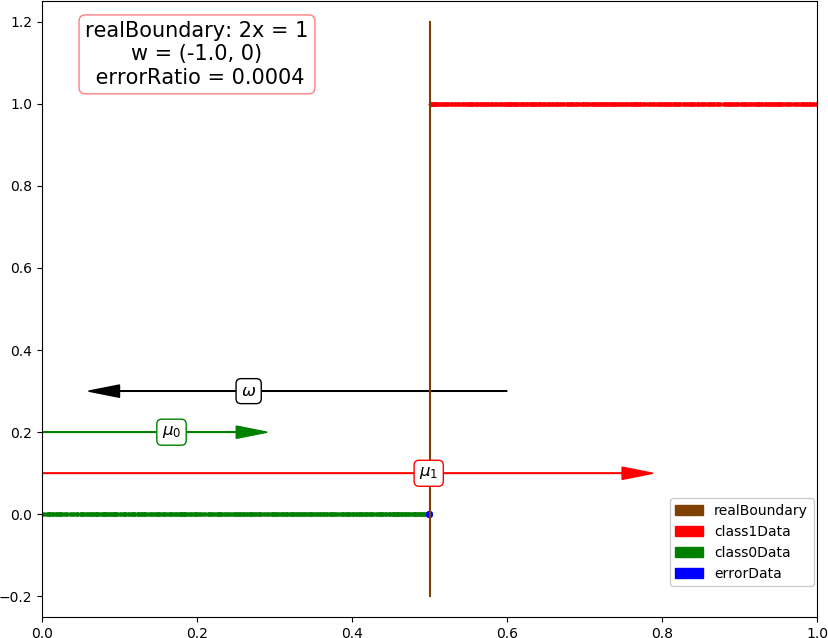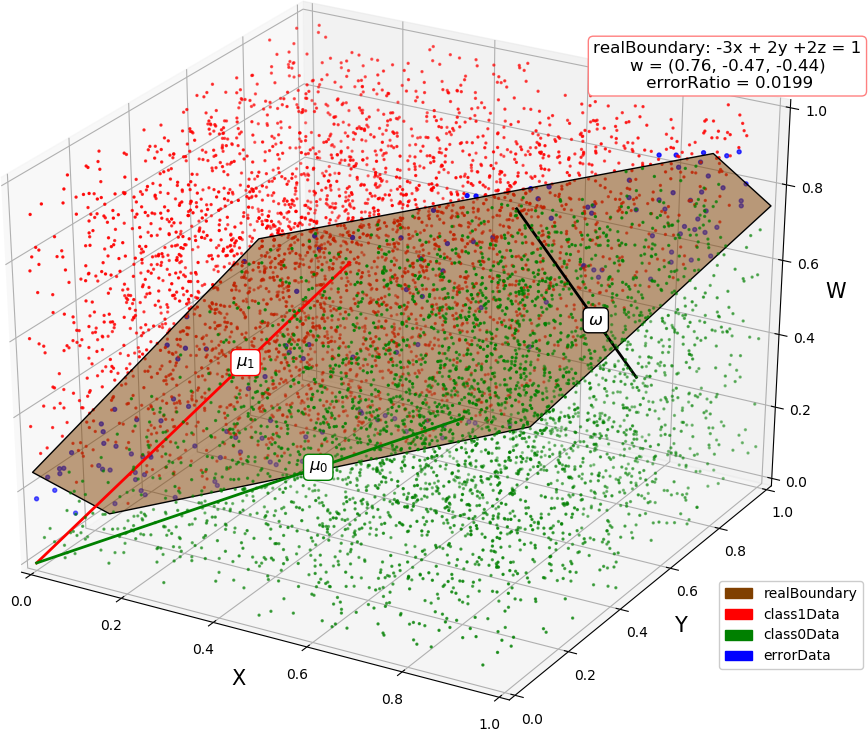▶ 使用线性回归来为散点作分类
● 普通线性回归,代码
1 import numpy as np 2 import matplotlib.pyplot as plt 3 from mpl_toolkits.mplot3d import Axes3D 4 from mpl_toolkits.mplot3d.art3d import Poly3DCollection 5 from matplotlib.patches import Rectangle 6 7 dataSize = 10000 8 trainRatio = 0.3 9 colors = [[0.5,0.25,0],[1,0,0],[0,0.5,0],[0,0,1],[1,0.5,0]] # 棕红绿蓝橙 10 trans = 0.5 11 12 def dataSplit(data, part): # 将数据集分割为训练集和测试集 13 return data[0:part,:],data[part:,:] 14 15 def mySign(x): # 区分 np.sign() 16 return (1 + np.sign(x))/2 17 18 def function(x,para): # 连续回归函数 19 return np.sum(x * para[0]) + para[1] 20 21 def judge(x, para): # 分类函数,由乘加部分和阈值部分组成 22 return mySign(function(x, para) - 0.5) 23 24 def createData(dim, len): # 生成测试数据 25 np.random.seed(103) 26 output=np.zeros([len,dim+1]) 27 for i in range(dim): 28 output[:,i] = np.random.rand(len) 29 output[:,dim] = list(map(lambda x : int(x > 0.5), (3 - 2 * dim)*output[:,0] + 2 * np.sum(output[:,1:dim], 1))) 30 #print(output, " ", np.sum(output[:,-1])/len) 31 return output 32 33 def linearRegression(data): # 线性回归 34 len,dim = np.shape(data) 35 dim -= 1 36 if(dim) == 1: # 一元单独出来,其实可以合并到下面的 else 中 37 sumX = np.sum(data[:,0]) 38 sumY = np.sum(data[:,1]) 39 sumXY = np.sum([x*y for x,y in data]) 40 sumXX = np.sum([x*x for x in data[:,0]]) 41 w = (sumXY * len - sumX * sumY) / (sumXX * len - sumX * sumX) 42 b = (sumY - w * sumX) / len 43 return ([w] , b) 44 else: # 二元及以上,暂不考虑降秩的问题 45 dataE = np.concatenate((data[:,:-1], np.ones(len)[:,np.newaxis]), axis = 1) 46 w = np.matmul(np.matmul(np.linalg.inv(np.matmul(dataE.T, dataE)),dataE.T),data[:,-1]) # w = (X^T * X)^(-1) * X^T * y 47 return (w[:-1],w[-1]) 48 49 def test(dim): # 测试函数 50 allData = createData(dim, dataSize) 51 trainData, testData = dataSplit(allData, int(dataSize * trainRatio)) 52 53 para = linearRegression(trainData) 54 55 myResult = [ judge(i[0:dim], para) for i in testData ] 56 errorRatio = np.sum((np.array(myResult) - testData[:,-1].astype(int))**2) / (dataSize*(1-trainRatio)) 57 print("dim = "+ str(dim) + ", errorRatio = " + str(round(errorRatio,4))) 58 if dim >= 4: # 4维以上不画图,只输出测试错误率 59 return 60 61 errorP = [] # 画图部分,测试数据集分为错误类,1 类和 0 类 62 class1 = [] 63 class0 = [] 64 for i in range(np.shape(testData)[0]): 65 if myResult[i] != testData[i,-1]: 66 errorP.append(testData[i]) 67 elif myResult[i] == 1: 68 class1.append(testData[i]) 69 else: 70 class0.append(testData[i]) 71 errorP = np.array(errorP) 72 class1 = np.array(class1) 73 class0 = np.array(class0) 74 75 fig = plt.figure(figsize=(10, 8)) 76 77 if dim == 1: 78 plt.xlim(0.0,1.0) 79 plt.ylim(-0.25,1.25) 80 plt.plot([0.5, 0.5], [-0.5, 1.25], color = colors[0],label = "realBoundary") 81 plt.plot([0, 1], [ function(i, para) for i in [0,1] ],color = colors[4], label = "myF") 82 plt.scatter(class1[:,0], class1[:,1],color = colors[1], s = 2,label = "class1Data") 83 plt.scatter(class0[:,0], class0[:,1],color = colors[2], s = 2,label = "class0Data") 84 if len(errorP) != 0: 85 plt.scatter(errorP[:,0], errorP[:,1],color = colors[3], s = 16,label = "errorData") 86 plt.text(0.2, 1.12, "realBoundary: 2x = 1 myF(x) = " + str(round(para[0][0],2)) + " x + " + str(round(para[1],2)) + " errorRatio = " + str(round(errorRatio,4)), 87 size=15, ha="center", va="center", bbox=dict(boxstyle="round", ec=(1., 0.5, 0.5), fc=(1., 1., 1.))) 88 R = [Rectangle((0,0),0,0, color = colors[k]) for k in range(5)] 89 plt.legend(R, ["realBoundary", "class1Data", "class0Data", "errorData", "myF"], loc=[0.81, 0.2], ncol=1, numpoints=1, framealpha = 1) 90 91 if dim == 2: 92 plt.xlim(0.0,1.0) 93 plt.ylim(0.0,1.0) 94 plt.plot([0,1], [0.25,0.75], color = colors[0],label = "realBoundary") 95 xx = np.arange(0, 1 + 0.1, 0.1) 96 X,Y = np.meshgrid(xx, xx) 97 contour = plt.contour(X, Y, [ [ function((X[i,j],Y[i,j]), para) for j in range(11)] for i in range(11) ]) 98 plt.clabel(contour, fontsize = 10,colors='k') 99 plt.scatter(class1[:,0], class1[:,1],color = colors[1], s = 2,label = "class1Data") 100 plt.scatter(class0[:,0], class0[:,1],color = colors[2], s = 2,label = "class0Data") 101 if len(errorP) != 0: 102 plt.scatter(errorP[:,0], errorP[:,1],color = colors[3], s = 8,label = "errorData") 103 plt.text(0.75, 0.92, "realBoundary: -x + 2y = 1 myF(x,y) = " + str(round(para[0][0],2)) + " x + " + str(round(para[0][1],2)) + " y + " + str(round(para[1],2)) + " errorRatio = " + str(round(errorRatio,4)), 104 size = 15, ha="center", va="center", bbox=dict(boxstyle="round", ec=(1., 0.5, 0.5), fc=(1., 1., 1.))) 105 R = [Rectangle((0,0),0,0, color = colors[k]) for k in range(4)] 106 plt.legend(R, ["realBoundary", "class1Data", "class0Data", "errorData"], loc=[0.81, 0.2], ncol=1, numpoints=1, framealpha = 1) 107 108 if dim == 3: 109 ax = Axes3D(fig) 110 ax.set_xlim3d(0.0, 1.0) 111 ax.set_ylim3d(0.0, 1.0) 112 ax.set_zlim3d(0.0, 1.0) 113 ax.set_xlabel('X', fontdict={'size': 15, 'color': 'k'}) 114 ax.set_ylabel('Y', fontdict={'size': 15, 'color': 'k'}) 115 ax.set_zlabel('W', fontdict={'size': 15, 'color': 'k'}) 116 v = [(0, 0, 0.25), (0, 0.25, 0), (0.5, 1, 0), (1, 1, 0.75), (1, 0.75, 1), (0.5, 0, 1)] 117 f = [[0,1,2,3,4,5]] 118 poly3d = [[v[i] for i in j] for j in f] 119 ax.add_collection3d(Poly3DCollection(poly3d, edgecolor = 'k', facecolors = colors[0]+[trans], linewidths=1)) 120 ax.scatter(class1[:,0], class1[:,1],class1[:,2], color = colors[1], s = 2, label = "class1") 121 ax.scatter(class0[:,0], class0[:,1],class0[:,2], color = colors[2], s = 2, label = "class0") 122 if len(errorP) != 0: 123 ax.scatter(errorP[:,0], errorP[:,1],errorP[:,2], color = colors[3], s = 8, label = "errorData") 124 ax.text3D(0.8, 1, 1.15, "realBoundary: -3x + 2y +2z = 1 myF(x,y,z) = " + str(round(para[0][0],2)) + " x + " + 125 str(round(para[0][1],2)) + " y + " + str(round(para[0][2],2)) + " z + " + str(round(para[1],2)) + " errorRatio = " + str(round(errorRatio,4)), 126 size = 12, ha="center", va="center", bbox=dict(boxstyle="round", ec=(1, 0.5, 0.5), fc=(1, 1, 1))) 127 R = [Rectangle((0,0),0,0, color = colors[k]) for k in range(4)] 128 plt.legend(R, ["realBoundary", "class1Data", "class0Data", "errorData"], loc=[0.83, 0.1], ncol=1, numpoints=1, framealpha = 1) 129 130 fig.savefig("R:\dim" + str(dim) + ".png") 131 plt.close() 132 133 if __name__ == '__main__': 134 test(1) 135 test(2) 136 test(3) 137 test(4)
● 输出结果
dim = 1, errorRatio = 0.003 dim = 2, errorRatio = 0.0307 dim = 3, errorRatio = 0.02 dim = 4, errorRatio = 0.0349
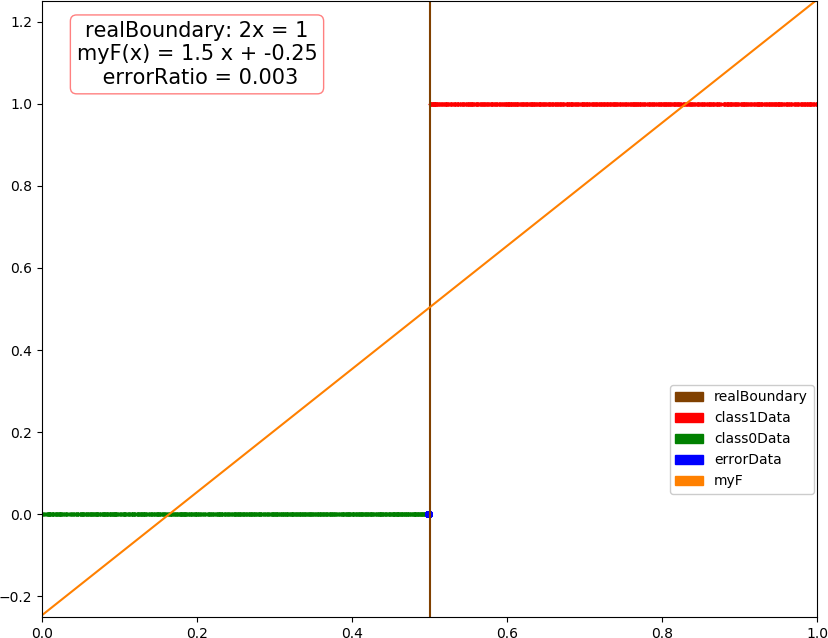
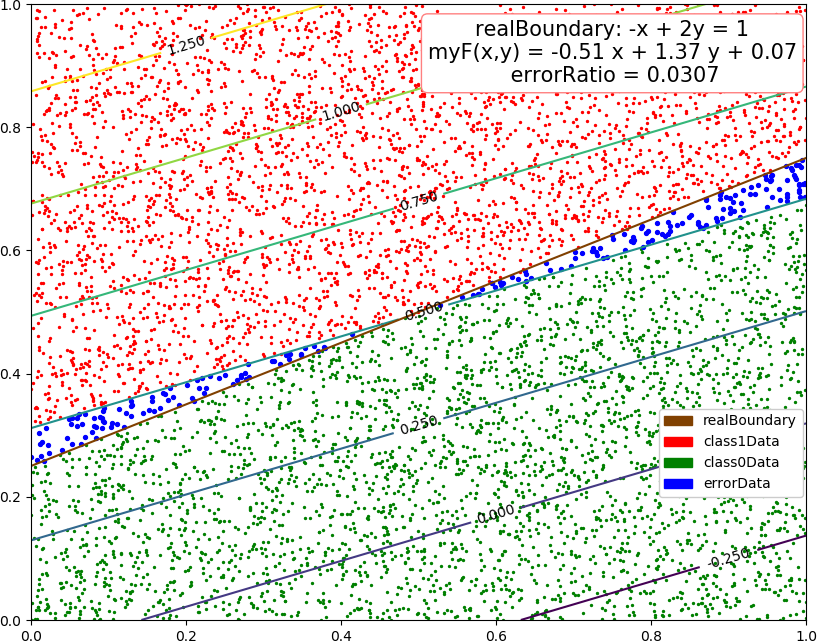
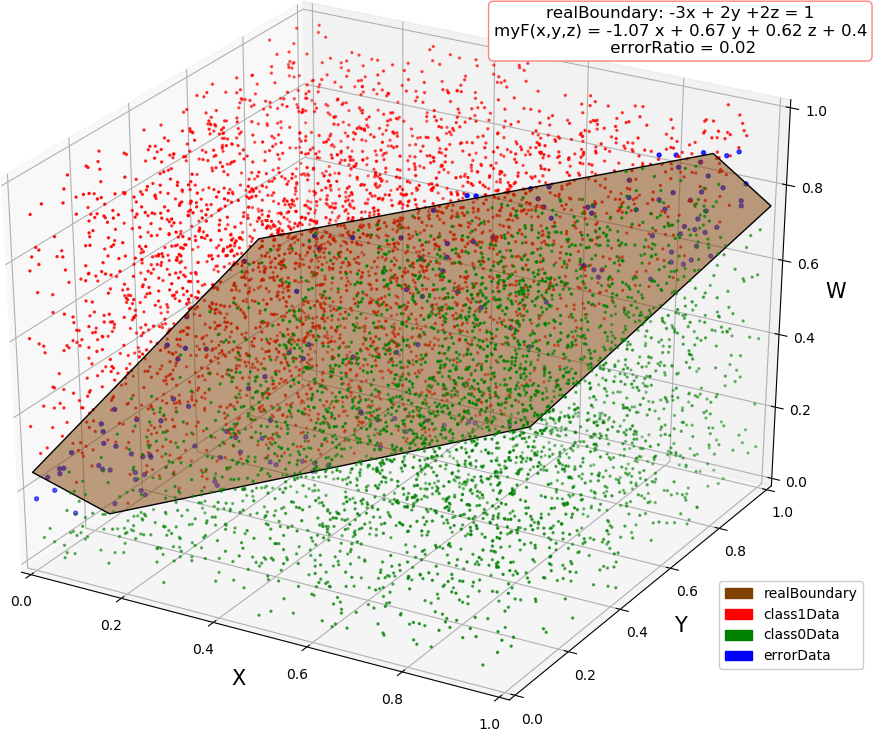
● LDA法,代码
1 import numpy as np 2 import matplotlib.pyplot as plt 3 from mpl_toolkits.mplot3d import Axes3D 4 from mpl_toolkits.mplot3d.art3d import Poly3DCollection 5 from matplotlib.patches import Rectangle 6 7 dataSize = 10000 8 trainRatio = 0.3 9 colors = [[0.5,0.25,0],[1,0,0],[0,0.5,0],[0,0,1],[1,0.5,0],[0,0,0]] # 棕红绿蓝橙黑 10 trans = 0.5 11 12 def dataSplit(data, part): # 将数据集分割为训练集和测试集 13 return data[0:part,:],data[part:,:] 14 15 def dot(x, w): # 内积,返回标量 16 return np.sum(x * w) 17 18 def judge(x, w, mu1pro, mu0pro): # 分类函数直接用欧氏距离 19 return int(2 * dot(mu0pro - mu1pro, w * dot(x, w))< (dot(mu0pro, mu0pro) - dot(mu1pro, mu1pro))) 20 21 def createData(dim, len): # 生成测试数据 22 np.random.seed(103) 23 output = np.zeros([len,dim+1]) 24 for i in range(dim): 25 output[:,i] = np.random.rand(len) 26 output[:,dim] = list(map(lambda x : int(x > 0.5), (3 - 2 * dim)*output[:,0] + 2 * np.sum(output[:,1:dim], 1))) 27 #print(output, " ", np.sum(output[:,-1])/len) 28 return output 29 30 def linearDiscriminantAnalysis(data): # LDA 法 31 dim = np.shape(data)[1] - 1 32 class1 = [] 33 class0 = [] 34 for line in data: 35 if line[-1] > 0.5: 36 class1.append(line) 37 else: 38 class0.append(line) 39 class1 = np.array(class1) 40 class0 = np.array(class0) 41 mu1 = np.sum(class1[:,0:dim],0) / np.shape(class1)[0] 42 mu0 = np.sum(class0[:,0:dim],0) / np.shape(class0)[0] 43 temp1 = class1[:,0:dim] - mu1 44 temp0 = class0[:,0:dim] - mu0 45 w = np.matmul(np.linalg.inv(np.matmul(temp1.T,temp1) + np.matmul(temp0.T,temp0)),mu0 - mu1) # w = Sw^(-1) * (mu0 - m1) 46 return (w / np.sqrt(dot(w, w)), mu1, mu0) 47 48 def test(dim): # 测试函数 49 allData = createData(dim, dataSize) 50 trainData, testData = dataSplit(allData, int(dataSize * trainRatio)) 51 52 para = linearDiscriminantAnalysis(trainData) 53 mu1pro = para[0] * dot(para[1], para[0]) 54 mu0pro = para[0] * dot(para[2], para[0]) 55 myResult = [ judge(i[0:dim], para[0], mu1pro, mu0pro) for i in testData ] 56 errorRatio = np.sum((np.array(myResult) - testData[:,-1].astype(int))**2) / (dataSize*(1-trainRatio)) 57 print("dim = "+ str(dim) + ", errorRatio = " + str(round(errorRatio,4))) 58 if dim >= 4: # 4维以上不画图,只输出测试错误率 59 return 60 61 errorP = [] # 画图部分,测试数据集分为错误类,1 类和 0 类 62 class1 = [] 63 class0 = [] 64 for i in range(np.shape(testData)[0]): 65 if myResult[i] != testData[i,-1]: 66 errorP.append(testData[i]) 67 elif myResult[i] == 1: 68 class1.append(testData[i]) 69 else: 70 class0.append(testData[i]) 71 errorP = np.array(errorP) 72 class1 = np.array(class1) 73 class0 = np.array(class0) 74 75 fig = plt.figure(figsize=(10, 8)) 76 77 if dim == 1: 78 plt.xlim(0.0,1.0) 79 plt.ylim(-0.25,1.25) 80 plt.plot([0.5, 0.5], [-0.2, 1.2], color = colors[0],label = "realBoundary") 81 plt.arrow(0.6, 0.3, para[0][0]/2, 0, head_width=0.03, head_length=0.04, fc=colors[5], ec=colors[5]) 82 plt.arrow(0, 0.1, para[1][0], 0, head_width=0.03, head_length=0.04, fc=colors[1], ec=colors[1]) 83 plt.arrow(0, 0.2, para[2][0], 0, head_width=0.03, head_length=0.04, fc=colors[2], ec=colors[2]) 84 plt.scatter(class1[:,0], class1[:,1],color = colors[1], s = 2,label = "class1Data") 85 plt.scatter(class0[:,0], class0[:,1],color = colors[2], s = 2,label = "class0Data") 86 if len(errorP) != 0: 87 plt.scatter(errorP[:,0], errorP[:,1],color = colors[3], s = 16,label = "errorData") 88 plt.text(0.2, 1.12, "realBoundary: 2x = 1 w = (" + str(round(para[0][0],2)) + ", 0) errorRatio = " + str(round(errorRatio,4)), 89 size=15, ha="center", va="center", bbox=dict(boxstyle="round", ec=(1., 0.5, 0.5), fc=(1., 1., 1.))) 90 plt.text(0.6 + para[0][0]/3,0.3, "$omega$", size = 12, ha="center", va="center", bbox=dict(boxstyle="round", ec=colors[5], fc=(1., 1., 1.))) 91 plt.text(para[1][0]*2/3,0.1, "$mu_{1}$", size = 12, ha="center", va="center", bbox=dict(boxstyle="round", ec=colors[1], fc=(1., 1., 1.))) 92 plt.text(para[2][0]*2/3,0.2, "$mu_{0}$", size = 12, ha="center", va="center", bbox=dict(boxstyle="round", ec=colors[2], fc=(1., 1., 1.))) 93 R = [Rectangle((0,0),0,0, color = colors[k]) for k in range(4)] 94 plt.legend(R, ["realBoundary", "class1Data", "class0Data", "errorData"], loc=[0.81, 0.05], ncol=1, numpoints=1, framealpha = 1) 95 96 if dim == 2: 97 plt.xlim(0.0,1.0) 98 plt.ylim(0.0,1.0) 99 plt.plot([0,1], [0.25,0.75], color = colors[0],label = "realBoundary") 100 101 plt.arrow(0.6, 0.75, para[0][0]/2, para[0][1]/2, head_width=0.015, head_length=0.04, fc=colors[5], ec=colors[5]) 102 plt.arrow(0, 0, para[1][0], para[1][1], head_width=0.015, head_length=0.04, fc=colors[1], ec=colors[1]) 103 plt.arrow(0, 0, para[2][0], para[2][1], head_width=0.015, head_length=0.04, fc=colors[2], ec=colors[2]) 104 plt.scatter(class1[:,0], class1[:,1],color = colors[1], s = 2,label = "class1Data") 105 plt.scatter(class0[:,0], class0[:,1],color = colors[2], s = 2,label = "class0Data") 106 if len(errorP) != 0: 107 plt.scatter(errorP[:,0], errorP[:,1],color = colors[3], s = 8,label = "errorData") 108 plt.text(0.81, 0.92, "realBoundary: -x + 2y = 1 w = (" + str(round(para[0][0],2)) + ", " + str(round(para[0][1],2)) + ") errorRatio = " + str(round(errorRatio,4)), 109 size = 15, ha="center", va="center", bbox=dict(boxstyle="round", ec=(1., 0.5, 0.5), fc=(1., 1., 1.))) 110 plt.text(0.6 + para[0][0]/3,0.75+para[0][1]/3, "$omega$", size = 12, ha="center", va="center", bbox=dict(boxstyle="round", ec=colors[5], fc=(1., 1., 1.))) 111 plt.text(para[1][0]*2/3,para[1][1]*2/3, "$mu_{1}$", size = 12, ha="center", va="center", bbox=dict(boxstyle="round", ec=colors[1], fc=(1., 1., 1.))) 112 plt.text(para[2][0]*2/3,para[2][1]*2/3, "$mu_{0}$", size = 12, ha="center", va="center", bbox=dict(boxstyle="round", ec=colors[2], fc=(1., 1., 1.))) 113 114 R = [Rectangle((0,0),0,0, color = colors[k]) for k in range(4)] 115 plt.legend(R, ["realBoundary", "class1Data", "class0Data", "errorData"], loc=[0.81, 0.35], ncol=1, numpoints=1, framealpha = 1) 116 117 if dim == 3: 118 ax = Axes3D(fig) 119 ax.set_xlim3d(0.0, 1.0) 120 ax.set_ylim3d(0.0, 1.0) 121 ax.set_zlim3d(0.0, 1.0) 122 ax.set_xlabel('X', fontdict={'size': 15, 'color': 'k'}) 123 ax.set_ylabel('Y', fontdict={'size': 15, 'color': 'k'}) 124 ax.set_zlabel('W', fontdict={'size': 15, 'color': 'k'}) 125 v = [(0, 0, 0.25), (0, 0.25, 0), (0.5, 1, 0), (1, 1, 0.75), (1, 0.75, 1), (0.5, 0, 1)] 126 f = [[0,1,2,3,4,5]] 127 poly3d = [[v[i] for i in j] for j in f] 128 ax.add_collection3d(Poly3DCollection(poly3d, edgecolor = 'k', facecolors = colors[0]+[trans], linewidths=1)) 129 ax.plot([0.6, 0.6 + para[0][0]/2],[0.75, 0.75 + para[0][1]/2],[0.75, 0.75 + para[0][2]/2], color = colors[5], linewidth = 2) # 手工线段代替箭头 130 ax.plot([0,para[1][0]],[0,para[1][1]],[0,para[1][2]], color = colors[1], linewidth = 2) 131 ax.plot([0,para[2][0]],[0,para[2][1]],[0,para[2][2]], color = colors[2], linewidth = 2) 132 ax.scatter(class1[:,0], class1[:,1],class1[:,2], color = colors[1], s = 2, label = "class1") 133 ax.scatter(class0[:,0], class0[:,1],class0[:,2], color = colors[2], s = 2, label = "class0") 134 if len(errorP) != 0: 135 ax.scatter(errorP[:,0], errorP[:,1],errorP[:,2], color = colors[3], s = 8, label = "errorData") 136 ax.text3D(0.85, 1.1, 1.03, "realBoundary: -3x + 2y +2z = 1 w = (" + str(round(para[0][0],2)) + ", " + str(round(para[0][1],2)) + ", " + str(round(para[0][2],2)) +") errorRatio = " + str(round(errorRatio,4)), 137 size = 12, ha="center", va="center", bbox=dict(boxstyle="round", ec=(1, 0.5, 0.5), fc=(1, 1, 1))) 138 ax.text3D(0.6 + para[0][0]/3,0.75+para[0][1]/3, 0.75+para[0][2]/3, "$omega$", size = 12, ha="center", va="center", bbox=dict(boxstyle="round", ec=colors[5], fc=(1., 1., 1.))) 139 ax.text3D(para[1][0]*2/3,para[1][1]*2/3, para[1][2]*2/3, "$mu_{1}$", size = 12, ha="center", va="center", bbox=dict(boxstyle="round", ec=colors[1], fc=(1., 1., 1.))) 140 ax.text3D(para[2][0]*2/3,para[2][1]*2/3, para[2][2]*2/3, "$mu_{0}$", size = 12, ha="center", va="center", bbox=dict(boxstyle="round", ec=colors[2], fc=(1., 1., 1.))) 141 142 R = [Rectangle((0,0),0,0, color = colors[k]) for k in range(4)] 143 plt.legend(R, ["realBoundary", "class1Data", "class0Data", "errorData"], loc=[0.83, 0.1], ncol=1, numpoints=1, framealpha = 1) 144 145 fig.savefig("R:\dim" + str(dim) + ".png") 146 plt.close() 147 148 if __name__ == '__main__': 149 test(1) 150 test(2) 151 test(3) 152 test(4)
● 输出结果
dim = 1, errorRatio = 0.0004 dim = 2, errorRatio = 0.0309 dim = 3, errorRatio = 0.0199 dim = 4, errorRatio = 0.0349
